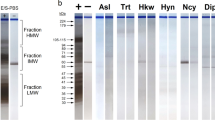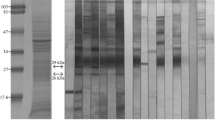Abstract
Background
Larval toxocarosis is a zoonosis caused by larvae of Toxocara canis and T. cati, a gastrointestinal nematode of canids and felids, respectively. Diagnosis is usually performed by ELISA IgG using Toxocara excretory–secretory products as an antigen. Due to laboriousness of isolation of the products and subsequent process of standardization of antigenic compounds, routine use of this method is limited and can produce inaccurate diagnostical results. The purpose of this study was to discover new specific antigenic proteins that could be used in routine serological methods of larval toxocarosis.
Materials and Methods
Toxocara excretory–secretory products were collected and separated by SDS-PAGE. Proteins from the gel were electro-transferred to a membrane and incubated with mouse sera. Antigenic proteins were analyzed using the liquid chromatography–tandem mass spectrometry approach. Selected proteins were prepared in recombinant form and tested with mice and human sera by ELISA and Western blot.
Results
A total of four recombinant protein antigens were prepared (rTc-TES-26, rTc-ASA, rTc-PDP, and rTc-ASP). They were analyzed by ELISA and Western blot using mice and human sera. For all sera, three of the four recombinant antigens correlated with Toxocara excretory–secretory products in ELISA analysis. By Western blot, the infection was confirmed in all experimentally infected mice and two out of seven human patients.
Conclusion
Combination of the presented methods and analyses represents a possible method of effective identification of Toxocara protein antigens for the purpose of routine serodiagnosis.



Similar content being viewed by others
References
Rostami A, Riahi SM, Holland CV, Taghipour A, Khalili-Fomeshi M, Fakhri Y, Omrani VF, Hotez PJ, Gasser RB (2019) Seroprevalence estimates for toxocariasis in people worldwide: a systematic review and meta-analysis. PLoS Negl Trop Dis 13:e0007809. https://doi.org/10.1371/journal.pntd.0007809
Strube C, Heuer L, Janecek E (2013) Toxocara spp. infections in paratenic hosts. Vet Parasitol 193:375–389. https://doi.org/10.1016/j.vetpar.2012.12.033
Despommier D (2003) Toxocariasis: clinical aspects, epidemiology, medical ecology, and molecular aspects. Clin Microbiol Rev 16:265–272. https://doi.org/10.1128/CMR.16.2.265
Ma G, Holland CV, Wang T, Fan CK, Maizels RM, Hotez PJ, Gasser RB (2018) Human toxocariasis. Lancet Infect Dis 18:e14–e24. https://doi.org/10.1016/S1473-3099(17)30331-6
Ishida MM, Rubinsky-Elefant G, Ferreira AW, Hoshino-Shimizu S, Vaz AJ (2003) Helminth antigens (Taenia solium, Taenia crassiceps, Toxocara canis, Schistosoma mansoni and Echinococcus granulosus) and cross-reactivities in human infections and immunized animals. Acta Trop 89:73–84. https://doi.org/10.1016/j.actatropica.2003.09.005
Smith HV, Holland CV, Taylor M, Magnaval JF, Schantz PM, Maizels RM (2009) How common is human toxocariasis? Towards standardizing our knowledge. Trends Parasitol. https://doi.org/10.1016/j.pt.2009.01.006
Zhu XQ, Korhonen PK, Cai H, Young ND, Nejsum P, Von Samson-Himmelstjerna G, Boag PR, Tan P, Li Q, Min J, Yang Y, Wang X, Fang X, Hall RS, Hofmann A, Sternberg PW, Jex AR, Gasser RB (2015) Genetic blueprint of the zoonotic pathogen Toxocara canis. Nat Commun 6:1–8. https://doi.org/10.1038/ncomms7145
Sperotto RL, Kremer FS, Aires Berne ME, Costa de Avila LF, da Silva PL, Monteiro KM, Caumo KS, Ferreira HB, Berne N, Borsuk S (2017) Proteomic analysis of Toxocara canis excretory and secretory (TES) proteins. Mol Biochem Parasitol 211:39–47. https://doi.org/10.1016/j.molbiopara.2016.09.002
da Silva MB, Urrego AJR, Oviedo Y, Cooper PJ, Pacheco LG, Pinheiro CS, Ferreira F, Briza P, Alcantara-Neves NM (2018) The somatic proteins of Toxocara canis larvae and excretory-secretory products revealed by proteomics. Vet Parasitol 259:25–34. https://doi.org/10.1016/j.vetpar.2018.06.015
Maizels RM, de Savigny D, Ogilvie BM (1984) Characterization of surface and excretory-secretory antigens of Toxocara canis infective larvae. Parasite Immunol 6:23–37. https://doi.org/10.1111/j.1365-3024.1984.tb00779.x
Gems D, Ferguson CJ, Robertson BD, Nieves R, Page AP, Blaxter ML, Maizels RM (1995) An abundant, trans-spliced mRNA from Toxocara canis infective larvae encodes a 26-kDa protein with homology to phosphatidylethanolamine-binding proteins. J Biol Chem 270:18517–18522
Loukas A, Hintz M, Linder D, Mullin NP, Parkinson J, Tetteh KK, Maizels RM (2000) A family of secreted mucins from the parasitic nematode Toxocara canis bears diverse mucin domains but shares similar flanking six-cysteine repeat motifs. J Biol Chem 275:39600–39607. https://doi.org/10.1074/jbc.M005632200
Doedens A, Loukas A, Maizels RM (2001) A cDNA encoding Tc-MUC-5, a mucin from Toxocara canis larvae identified by expression screening. Acta Trop 79:211–217. https://doi.org/10.1016/S0001-706X(01)00137-1
Page AP, Rudin W, Fluri E, Blaxter ML, Maizels RM (1992) Toxocara canis: a labile antigenic surface coat overlying the epicuticle of infective larvae. Exp Parasitol 75:72–86. https://doi.org/10.1016/0014-4894(92)90123-R
Page AP, Hamilton AJ, Maizels RM (1992) Toxocara canis: Monoclonal antibodies to carbohydrate epitopes of secreted (TES) antigens localize to different secretion-related structures in infective larvae. Exp Parasitol 75:56–71. https://doi.org/10.1016/0014-4894(92)90122-Q
Loukas A, Mullin NP, Tetteh KK, Moens L, Maizels RM (1999) A novel C-type lectin secreted by a tissue-dwelling parasitic nematode. Curr Biol 9:825–828. https://doi.org/10.1016/S0960-9822(99)80366-2
Maizels RM, Tetteh KK, Loukas A (2000) Toxocara canis: genes expressed by the arrested infective larval stage of a parasitic nematode. Int J Parasitol 30:495–508. https://doi.org/10.1016/s0020-7519(00)00022-9
Tetteh KK, Loukas A, Tripp C, Maizels RM (1999) Identification of abundantly expressed novel and conserved genes from the infective larval stage of Toxocara canis by an expressed sequence tag strategy. Infect Immun 67:4771–4779. https://doi.org/10.1128/IAI.67.9.4771-4779.1999
Zhan B, Ajmera R, Geiger SM, Gonçalves MTP, Liu Z, Wei J, Wilkins PP, Fujiwara R, Gazzinelli-Guimaraes PH, Bottazzi ME, Hotez P (2015) Identification of immunodominant antigens for the laboratory diagnosis of toxocariasis. Trop Med Int Heal 20:1787–1796. https://doi.org/10.1111/tmi.12607
Mohamad S, Azmi NC, Noordin R (2009) Development and evaluation of a sensitive and specific assay for diagnosis of human toxocariasis by use of three recombinant antigens (TES-26, TES-30USM, and TES-120). J Clin Microbiol 47:1712–1717. https://doi.org/10.1128/JCM.00001-09
Dos Santos LM, Donassolo RA, Berne ME, Leite FPL, Da Costa Avila LF, Scaini CJ, Moreira ÂN, Conceição FR (2019) The serodiagnostic potential of recombinant proteins TES–30 and TES–120 in an indirect ELISA in the diagnosis of toxocariasis in cattle, horses, and sheep. PLoS ONE 14:1–10. https://doi.org/10.1371/journal.pone.0213830
Raulf MK, Jordan D, Auer H, Warnecke JM, Lepenies B, Strube C (2020) A new ELISA and Western Blot technique based on recombinant TES antigen and/or larval antigen for the detection of toxocariasis in humans. Parasitology. https://doi.org/10.1017/S0031182020002085
Varghese A, Raina OK, Chandra D, Mirdha BR, Kelawala NH, Solanki JB, Kumar N, Ravindran R, Arun A, Rialch A, Lalrinkima H, Kelawala RN, Samanta S (2017) Sero-detection of Toxocara canis infection in human with T.canis recombinant arginine kinase, cathepsin L-1 and TES-26 antigens. Acta Parasitol 62:775–778. https://doi.org/10.1515/ap-2017-0093
Ebrahimi M, Seyyedtabaei SJ, Ranjbar MM, Tahvildar-biderouni F, Javadi-Mamaghani A (2020) Designing and modeling of multi-epitope proteins for diagnosis of Toxocara canis infection. Int J Pept Res Ther 26:1371–1380. https://doi.org/10.1007/s10989-019-09940-1
de Savigny DH (1975) In vitro maintenance of Toxocara canis larvae and a simple method for the production of Toxocara ES antigen for use in serodiagnostic tests for visceral larva migrans. J Parasitol 61:781–782. https://doi.org/10.2307/3279492
Frey A, Di Canzio J, Zurakowski D (1998) A statistically defined endpoint titer determination method for immunoassays. J Immunol Methods 221:35–41. https://doi.org/10.1016/s0022-1759(98)00170-7
Petersen TN, Brunak S, Von Heijne G, Nielsen H (2011) SignalP 4.0: discriminating signal peptides from transmembrane regions. Nat Methods 8:785–786
Artimo P, Jonnalagedda M, Arnold K, Baratin D, Csardi G, de Castro E, verine Duvaud S, Flegel V, Fortier A, Gasteiger E, lien Grosdidier A, line Hernandez C, Ioannidis V, Kuznetsov D, Liechti R, bastien Moretti S, Mostaguir K, Redaschi N, goire Rossier G, Xenarios I, Stockinger H (2012) ExPASy: SIB bioinformatics resource portal. Nucleic Acids Res 40:W597–W603. https://doi.org/10.1093/nar/gks400
Kong J, Won J, Yoon J, Lee UJ, Il KJ, Huh S (2016) Draft genome of Toxocara canis, a pathogen responsible for visceral larva migrans. Korean J Parasitol 54:751–758. https://doi.org/10.3347/kjp.2016.54.6.751
Kiel M, Josh P, Jones A, Windon R, Hunt P, Kongsuwan K (2007) Identification of immuno-reactive proteins from a sheep gastrointestinal nematode, Trichostrongylus colubriformis, using two-dimensional electrophoresis and mass spectrometry. Int J Parasitol 37:1419–1429. https://doi.org/10.1016/j.ijpara.2007.04.016
González-Miguel J, Rosario L, Rota-Nodari E, Morchón R, Simón F (2010) Identification of immunoreactive proteins of Dirofilaria immitis and D. repens recognized by sera from patients with pulmonary and subcutaneous dirofilariosis. Parasitol Int 59:248–256. https://doi.org/10.1016/j.parint.2010.02.010
Bien J, Cabaj W, Moskwa B (2015) Proteomic analysis of potential immunoreactive proteins from muscle larvae and adult worms of Trichinella spiralis in experimentally infected pigs. Folia Parasitol (Praha) 62:1–8. https://doi.org/10.14411/fp.2015.022
Novák J, Panská L, Macháček T, Kolářová L, Horák P (2017) Humoral response of mice infected with Toxocara canis following different infection schemes. Acta Parasitol 62:823–835. https://doi.org/10.1515/ap-2017-0099
Smith H, Noordin R (2006) Diagnostic limitations and future trends in the serodiagnosis of human toxocariasis. In: Holland CV, Smith HV (eds) Toxocara: the enigmatic parasite. CABI Publishing, Wallingford, pp 89–112
Magnaval JF, Fabre R, Maurières P, Charlet JP, de Larrard B (1991) Application of the Western blotting procedure for the immunodiagnosis of human toxocariasis. Parasitol Res 77:697–702. https://doi.org/10.1007/BF00928685
Deutz A, Fuchs K, Auer H, Kerbl U, Aspöck H, Köfer J (2005) Toxocara-infestations in Austria: a study on the risk of infection of farmers, slaughterhouse staff, hunters and veterinarians. Parasitol Res 97:390–394. https://doi.org/10.1007/s00436-005-1469-5
Skulinová K, Novák J, Kašný M, Kolářová L (2020) Seroprevalence of Larval Toxocarosis in the Czech Republic. Acta Parasitol 65:68–76. https://doi.org/10.2478/s11686-019-00121-0
Hotez PJ (2018) Human parasitology and parasitic diseases: heading towards. In: Rollinson D, Stothard JR (eds) Advances in parasitology, 1st edn. Elsevier Ltd, pp 29–38
Acknowledgements
The CEITEC Proteomics Core Facility is gratefully acknowledged for obtaining the scientific data presented in this paper. We would like to thank the Laboratory of Helminthology (Department of Parasitology, Faculty of Science, Charles University) and the Institute of Organic Chemistry and Biochemistry (Czech Academy of Sciences) for technical support, Pavel Roudnický and Jiří Vorel for help with data analysis, and Anna Pilátová, PhD., for editing the final draft.
Funding
The study was supported by Charles University, programs GAUK 902 217, SVV 260 520, Progres Q25.
Author information
Authors and Affiliations
Corresponding author
Ethics declarations
Conflict of interest
The authors report no conflict of interest.
Additional information
Publisher's Note
Springer Nature remains neutral with regard to jurisdictional claims in published maps and institutional affiliations.
Rights and permissions
About this article
Cite this article
Skulinová, K., Novák, J., Kolářová, L. et al. Antigenic Proteins from the Excretory–Secretory Products of Toxocara canis Larvae and Evaluation of Their Potential for Immunodiagnostics of Larval Toxocarosis. Acta Parasit. 67, 705–713 (2022). https://doi.org/10.1007/s11686-021-00485-2
Received:
Accepted:
Published:
Issue Date:
DOI: https://doi.org/10.1007/s11686-021-00485-2




